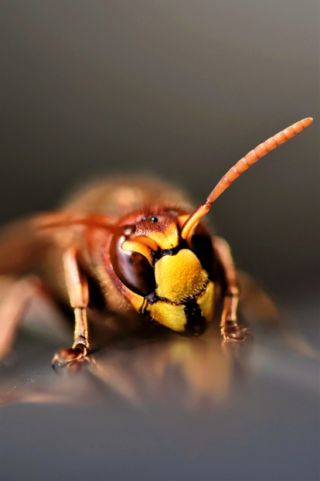
Source: Ralph_Fotos / Pixabay
“By the way,” said the service technician as he was leaving, “Did you know you have a bald-faced hornet’s nest above your garage?”
“No, I don’t think so.”
“It’s a big one. You might want to get that taken care of. They are nasty creatures. Have a good day.”
I immediately went outside to take a look. I did not see anything immediately above my garage. I looked up further, way up, about 50 feet. I stared for a few seconds to comprehend what I was looking at.
Above me hung a basketball-sized, beige-colored, oval-shaped nest. It seemed massive as it huddled inside the apex of the triangular frame, immediately below the top of the roof. I stared. My mouth probably hung open in disbelief.
Eerie was the best word to describe it. This looming object, filled with likely hundreds of one of the most aggressive species of hornets on the planet, was attached to my home. My family of five, consisting of three young children, had laughed and played as it hung above them.
Strengths Blindness
I was perplexed. How could this be? And even more astonishing: How did I not see this for the weeks or months it had been growing above me? How did my family, some of whom are highly detail-oriented about their environment, never notice it? And visitors to our home and neighbors?
This was the perfect example of “hiding in plain sight.”
This brought me to think about how positive qualities function in a similar way. Research shows we often do not see the good qualities in us unless someone points them out. This goes by names such as strengths blindness, the introspection illusion, and character strengths underuse.
For example, when expressed by standing up for someone or making a difficult personal change, your character strength of bravery is rarely noticed and appreciated as bravery. It takes others to point it out to us—”what you did back there was very brave”—for us to begin to see it.
What else do we not see in ourselves? What good qualities, hidden potential, are we neglecting every day?
A Science of Awe
I continued to observe the bald-faced hornet’s nest. Within those initial seconds, another feeling emerged strongly and perhaps more clearly and all-encompassing than all the others: Awe. This object was unbelievably incredible.
There were layers upon layers of paper mâché material created from the hornet saliva and pieces of wood. Something so large had been created quickly from such a tiny colony of creatures. The speed and creativity at which these hornets made something beautiful was striking.
Scientists have studied awe and found many triggers for this complex emotion. While natural scenery might be the most common, observing great skill is another common trigger.
I was in awe as I saw the result of great skill. This continued in plain sight as hornets flew around and into the nest. The awe had positive and negative features. It was stunning, beautiful, unique, and haunting, concerning, disturbing. Scientists call these descriptions positive awe and negative awe, and distinct neural correlates exist for both types of awe.
My character strength of the love of learning kicked in. I learned that bald-faced hornets can recognize human faces. Their brains can process an intruder who has returned—and couple that with their predictable aggression.
It is also true that one hornet can sting perpetrators multiple times (with no harm to themselves) and, more concerning, shoot venom from their stinger into the perpetrator’s eyes. This was not a pleasant combination of facts for me to ponder.
A Strengths Collision
The obvious question struck me: What do I do? Shall I have the nest removed, or shall I let it be? For some people, there is no tension with this situation, and they find themselves on one side or the other—and often feeling quite self-righteous, whichever side it is. I’ve heard from both sides.
For me, it was an intrapersonal collision of character strengths. Such collisions occur when two internal strengths are not in harmony, each pulling us in different directions. My character strength of love was a concern for my family, a problem, and care for their safety, especially three curious, playful children.
No doubt my prudence, strength of caution, and deliberateness were present. I had to express prudent love to protect my kids from hundreds of territorial, aggressive hornets whose nests could get knocked by a ball or be vulnerable to the elements of the weather. And, there was my character strength of appreciation of beauty in which I was filled with awe and enjoyment in studying the nest from afar; this strength was further expressed by my care for nature, desire not to kill other creatures, and appreciation of the harmony across life forms.
In addition, these hornets are good for the environment as, contrary to popular belief, they are pollinators, especially in the summertime, when I faced my intrapersonal strengths collision. I also felt a small degree of pride they had selected my home as a suitable environment for their colony.
Nevertheless, the collision did not last a long time. If I lived alone, my decision may have taken longer. My strength of love was too strong and loud due to my situation of protecting my home and children. Even a couple of environmentalist friends I spoke to agreed this was the right decision (although they said they would have disagreed if it had been a bee’s nest and then would have favored a “relocation” approach for the nest).
I had a specialized service come to my home to face the onslaught of hornets protecting their own home and their queen. Sadly, for them, they would not be successful.
After these actions were successful, along with preventative spraying, I was reassured my home would be hornet-free for a while, at least until next summer. I honored the experience by curiously studying and temporarily saving the seven or so layers of paper mâché nest and the small and large honeycombs strategically positioned within the nest that contained future generations of hornets.
Maintaining Character Strengths
The experts were wrong. I went on vacation for two weeks, and when I returned, my family was welcomed by the looming, eerie nest again. In this short period, it had grown to over half the basketball size of the original nest. How did this happen? Wasn’t there enough spray to deter any hornets that returned to the space to go off to another location?
One logical explanation was that the queen found a “safe room” in the nest during the attack and escaped safely out the back door.
My curiosity and awe continued as I marveled at the nest and the resilience of the hornets. They were inspiring, perseverant, and about as good at teamwork as a group of living beings could be.
Anthropomorphizing Strengths
I have described several examples of “strengths anthropomorphism,” in which character strengths—originally developed by humans to describe positive human personality traits—are applied to other living beings such as animals, trees, and other elements of nature. Our research has shown that all 24 character strengths can be ascribed to nature and that it is beneficial to human well-being and to nature’s connection to take such an approach.
In other words, when we see the character strengths of nature, we see our interrelationship with it.
In a future post, I will explore the emerging science of character strengths and nature connection.
Conclusion
Character strengths are typically unnoticed aspects of our personality. While we have a pervasive strengths blindness, we can deliberately find ways to see our character strengths in action. In addition, strengths can cause conflicts in ourselves or between ourselves and others, and awareness of these conflicts can serve as a path to resolution.
Bald-faced hornets should not be viewed in all-or-none terms. Like the emotion of awe, there are positive qualities and negative qualities. Our deep-rooted perceptions and fears often dictate how we will perceive such creatures and respond.
Slowing down to “see” nature as it is allows us to connect with nature more closely and perhaps see the character strengths it is exhibiting.


















+ There are no comments
Add yours